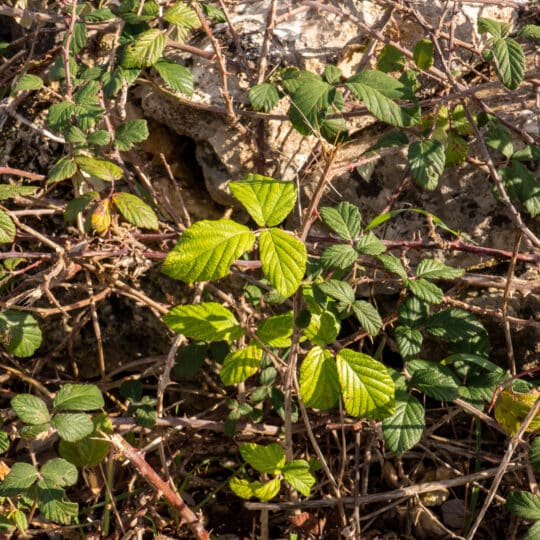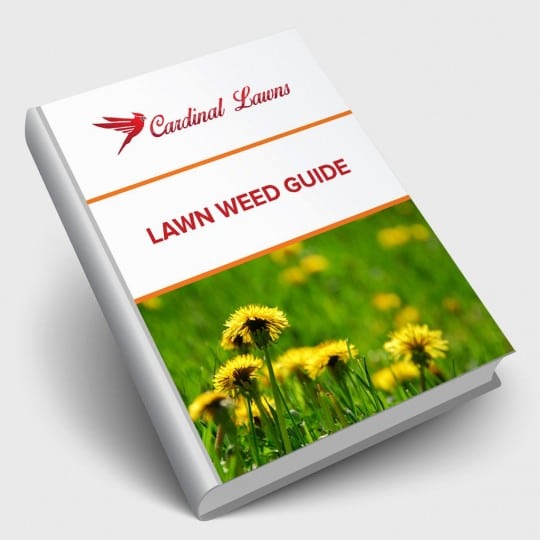9 Common Woody Weeds
and 5 Ways to Control Them
Posted
June 20, 2024

Whether you live near the woods or not, you may come across some forms of woody weeds in your lawn or garden. Not only can these invasive weeds take over other desirable plants, but some are poisonous and can cause an itchy reaction. Learn about woody weed control options tailored to the specific species and help protect your yard and family from any negative effects.
Identifying Woody Weeds
You don’t have to live in the woods to come across woody weeds. These plants can be trees, shrubs, or vines that have woody stems, roots, or both. Here are some of the most common types:
Poison Ivy
- Grows as a groundcover, shrub, or climbing vine.
- Thrives in moist or very dry soil and partial shade to full sun.
- Compound leaves feature three leaflets that grow from a reddish, woody stem.
- Young leaves are also reddish before turning shiny green in the spring, dull green in the summer, and yellow in the fall.
- Perennial weed loses its leaves in the winter, but the hairy vine remails and regrows in the spring.
- Contains an oily resin (urushiol) on its leaves, stems, and roots that can lead to a rash at the point of contact.
- Repeated cutting eventually kills the root system, but it can take several years to eradicate.
Poison Oak
- Another perennial known for rash-inducing urushiol.
- Grows as a dense, leafy shrub in open, sunny areas or a climbing vine in the shade.
- Three leaflets with toothed edges vary from glossy to dull and leathery to thin and turn red in the fall.
- Produces small white-green flowers that grow from leaf axils.
Kudzu
- A woody vine with large leaflets.
- Prefers full sun but also grows in the shade.
- Cut or mow the vine to the ground before treating the woody stumps with herbicides, which sometimes takes multiple applications and several seasons to get rid of.
English Holly
- A slow-growing evergreen shrub or small tree.
- Woody stems and leaves are oval-shaped and shiny.
- Thick, spikey leaves are dark green on top and light green underneath.
- Sweet-scented small, white flowers bloom in the spring and turn into orange, yellow, or red berries in the winter. The berries are poisonous to people and many animals, but not to birds that disperse the seeds, helping the plant spread.
English Ivy
- Some gardeners use as a low-maintenance ground cover.
- Evergreen, perennial woody vine easily chokes out native vegetation.
- Dark green leaves grow alternately and have whitish veins.
- Produces cluster of small greenish-yellow flowers from late summer to early fall and poisonous black, fleshy fruit with a stone-like seed center.
- Hand-pulling and repeated cutting can eventually kill the plant. Herbicide speeds up the process.
Virginia Creeper
- Perennial woody vine that can scale obstacles and walls with adhesive tendrils.
- Compound leaves have five tapered, toothed leaflets.
- Sap may cause a rash on sensitive skin.
- Grows well in full sun or shade and tolerates dry or soggy soil.
- From June to July, clusters of small, greenish-yellow flowers bloom and are replaced by poisonous dark blue-black berries that grow from the weed’s red stems.
Tree Of Heaven
- Gray bark and reddish-brown twigs with light green seed pods.
- Yellow-green flowers bloom in the spring.
- Produces a chemical that kills nearby plants.
- Aggressive root system can cause damage to nearby buildings.
- Remove the seedlings by hand before they develop the tap root.
Bramble
- Prickly shrubs with thorny stems include well-known plants like blackberry and raspberry bushes.
- Grow wild in neglected, sunny areas.
- Arching stems form dense thicket and root in places where the tips touch the soil.
Honeysuckle
- Egg-shaped leaves are sparsely hairy with a green top and pale green bottom.
- Flower from April to June. Either whitish-yellow or pinkish-white flowers.
- Produce red berries in late summer.
- Cut or pull the weeds in the fall and the spring. It may take a few years to kill the weed, especially if any root is left in the soil.
While all the woody weeds are slightly different, there are some similar methods of weed control.
Woody Weed Control
Like any weed, prevention is much easier than treatment. Maintaining a healthy lawn and garden will help stop weed seeds from spreading. If you do notice any weeds popping up, early identification and treatment can help lessen the problem. Here are some additional control methods to consider.
- Mulching. A thick layer of organic mulch not only helps suppress weeds, but it also helps improve soil health over time.
- Grazing. If you’re trying to control a large area of weed shrubs and trees, invite some goats and other livestock to graze in the woody weeded areas.
- Hand Pulling and Digging. When dealing with a few young plants, you can try to pull or dig them out of the ground. Make sure you remove the entire root system or else there’s a chance it will grow back. Of course, you want to be extra careful with any poisonous or thorny plant.
- Cutting and Mowing. The more you cut or mow down a woody weed, the more it can weaken over time. However, you want to make sure your tools are clean and sharpened for optimal results.
- Chemical Control. Larger infestations may require multiple herbicide applications. Choose the one that’s specially formulated to treat the weed you’re targeting. Some sprays require direct contact with the leaves, stump, or steam, so be sure to follow the directions and safety precautions closely.
Timing is also equally important when it comes to weed control. Catching a weed before it germinates will help you gain the upper hand. Using a combination of control methods also increases your chances of getting rid of woody weeds you don’t want. The key is regularly monitoring your landscape to notice any plants that pop up or persist after consistent control methods. You can also call Cardinal Lawns to help adapt your strategy and manage the weeds in your yard.

Download Your FREE Lawn Weed Guide
Before weeds take over your yard this season, learn to identify and prevent them in the first place. Keep your lawn looking great all year!